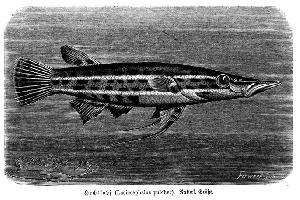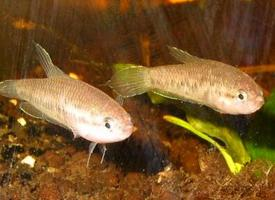
Description de l'animal
The Pikehead, scientifically known as Luciocephalus pulcher, is a unique and intriguing species of fish that belongs to the Osphronemidae family, which is also home to the more commonly known gouramis and bettas. The species name "pulcher" is derived from Latin, meaning "beautiful," which is a fitting descriptor for this visually striking fish. It is native to the freshwater environments of Southeast Asia, specifically in countries like Indonesia, Malaysia, and Thailand.The Pikehead has a distinctive body shape that resembles that of a pike, hence its common name. Its elongated body is sleek and somewhat laterally compressed, which allows it to maneuver swiftly through densely vegetated waters. Adult specimens can reach a length of up to 8 inches (20 centimeters), with males typically being larger and more vibrantly colored than females.
One of the most remarkable features of the Pikehead is its head, which is large and features a pointed snout. The fish's mouth is also quite sizable and is equipped with an array of sharp teeth, indicative of its carnivorous nature. The Pikehead's eyes are positioned on the sides of its head, giving it a broad field of vision to spot potential prey and predators alike.
The coloration of the Pikehead is a captivating blend of earthy tones, with a base color that ranges from olive green to brown. This is often accented with patterns of darker vertical stripes or splotches that provide excellent camouflage among the submerged vegetation and woody debris of its natural habitat. During breeding times or when displaying dominance, males may exhibit more intense colors, with hints of iridescent blues and greens, along with pronounced red or orange hues on their fins.
The Pikehead's fins are another aspect of its anatomy worth noting. The dorsal and anal fins are elongated and run almost the entire length of its body, culminating in a pointed caudal fin that aids in quick bursts of speed. The pectoral fins are also quite large and can be used for precise movements and hovering in place, which is especially useful when the Pikehead is stalking prey.
In the wild, the Pikehead's diet consists mainly of smaller fish, crustaceans, and insects. Its predatory nature is reflected in its hunting strategy, as it often lies in wait, camouflaged among the vegetation, before lunging out at unsuspecting prey with remarkable speed.
One fascinating aspect of the Pikehead's biology is its method of reproduction. Similar to other members of the Osphronemidae family, the Pikehead is a bubble-nest builder. The male constructs a floating nest out of bubbles that he secretes and reinforces with plant matter. After courtship, the female lays her eggs, which are then fertilized by the male and guarded within the bubble nest. The male diligently protects the nest and the developing fry until they are ready to fend for themselves.
The Pikehead's unique morphology and behavior make it a prized species among aquarium enthusiasts. However, its care requires a specialized setup that mimics its natural habitat, with ample vegetation and hiding places, as well as a diet that reflects its carnivorous preferences.
Conservation-wise, the Pikehead faces threats from habitat destruction, pollution, and the aquarium trade. Efforts to preserve its natural environments and ensure sustainable trade practices are crucial for the survival of this beautiful and remarkable fish in the wild.
Animaux similaires
Nouvelles photos d'animaux
Top 10 des animaux
- Dolphin gull (Leucophaeus scoresbii)
- Diana monkey (Cercopithecus diana)
- Moustached guenon (Cercopithecus cephus)
- Galápagos tortoise (Geochelone nigra complex)
- Japanese macaque (Macaca fuscata)
- Stone loach (Barbatula barbatula)
- Russian tortoise (Testudo horsfieldii)
- Greek tortoise (Testudo graeca)
- Common flying dragon (Draco volans)
- Vendace (Coregonus albula)


